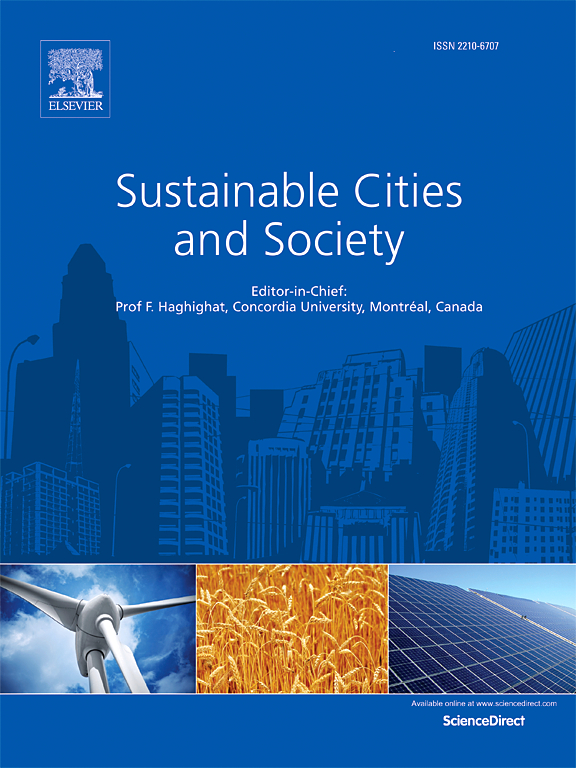作为气溶胶传播源的人类语言动力学:基于脉冲喷射理论的可持续城市健康影响
IF 10.5
1区 工程技术
Q1 CONSTRUCTION & BUILDING TECHNOLOGY
引用次数: 0
摘要
在可持续城市环境和公共卫生的背景下,本研究调查了发声过程中呼出的气流,以了解其流动动力学和传播特性。该研究利用照明高速成像和PIV技术,通过包括射流级、喷射次数、口尺度、方向、距离、速度、雷诺数和无量纲时间参数在内的综合参数来表征呼出流动,为流动描述和建模建立基线数据。通过类比脉冲射流,基于地层时间参数(t*inj)和地层数(Fn),识别出了两种不同的流型。制度A (t*inj <;Fn)表现为单涡环演化,而状态B (t*inj >;Fn)具有额外的尾随喷气机。形成数(Fn = 5.5-9.0)是这两种状态之间的关键过渡参数,涡圈涡度峰值约为70 s-1。分析表明,体积速度和注入时间可以作为简化CFD建模的关键参数,有待验证。由于喷射出的液滴倾向于在漩涡中集中和穿透,破坏这些结构可能会减少气溶胶的穿透和运输。这些发现有助于建立呼吸流模型和疾病传播控制的理论框架。本文章由计算机程序翻译,如有差异,请以英文原文为准。
Dynamics of human speech as aerosol transmission sources: Implications for sustainable urban health based on impulsive jet theory
In the context of sustainable urban environments and public health, this study investigates exhaled airflows during vocalization to understand their flow dynamics and transmission characteristics. Using illuminated high-speed imaging and PIV, the research characterizes exhaled flows through comprehensive parameters including jet flow stages, injection times, mouth scales, directions, distances, velocities, Reynolds numbers, and dimensionless time parameters, establishing baseline data for flow description and modeling. Through analogy with impulsive jets, two distinct flow regimes were identified based on formation time parameter (t*inj) and formation number (Fn). Regime A (t*inj < Fn) exhibits single vortex ring evolution, while Regime B (t*inj > Fn) features additional trailing jets. The formation number (Fn = 5.5–9.0) serves as a critical transition parameter between these regimes, with peak vortex ring vorticity reaching approximately 70 s-1. Analysis suggests that bulk velocity and injection time may serve as key parameters for simplified CFD modeling, pending validation. As expelled droplets tend to concentrate and penetrate in vortices, disrupting these structures may reduce aerosol penetration and transport. These findings contribute to the theoretical framework for respiratory flow modeling and disease transmission control.
求助全文
通过发布文献求助,成功后即可免费获取论文全文。
去求助
来源期刊

Sustainable Cities and Society
Social Sciences-Geography, Planning and Development
CiteScore
22.00
自引率
13.70%
发文量
810
审稿时长
27 days
期刊介绍:
Sustainable Cities and Society (SCS) is an international journal that focuses on fundamental and applied research to promote environmentally sustainable and socially resilient cities. The journal welcomes cross-cutting, multi-disciplinary research in various areas, including:
1. Smart cities and resilient environments;
2. Alternative/clean energy sources, energy distribution, distributed energy generation, and energy demand reduction/management;
3. Monitoring and improving air quality in built environment and cities (e.g., healthy built environment and air quality management);
4. Energy efficient, low/zero carbon, and green buildings/communities;
5. Climate change mitigation and adaptation in urban environments;
6. Green infrastructure and BMPs;
7. Environmental Footprint accounting and management;
8. Urban agriculture and forestry;
9. ICT, smart grid and intelligent infrastructure;
10. Urban design/planning, regulations, legislation, certification, economics, and policy;
11. Social aspects, impacts and resiliency of cities;
12. Behavior monitoring, analysis and change within urban communities;
13. Health monitoring and improvement;
14. Nexus issues related to sustainable cities and societies;
15. Smart city governance;
16. Decision Support Systems for trade-off and uncertainty analysis for improved management of cities and society;
17. Big data, machine learning, and artificial intelligence applications and case studies;
18. Critical infrastructure protection, including security, privacy, forensics, and reliability issues of cyber-physical systems.
19. Water footprint reduction and urban water distribution, harvesting, treatment, reuse and management;
20. Waste reduction and recycling;
21. Wastewater collection, treatment and recycling;
22. Smart, clean and healthy transportation systems and infrastructure;
 求助内容:
求助内容: 应助结果提醒方式:
应助结果提醒方式:


